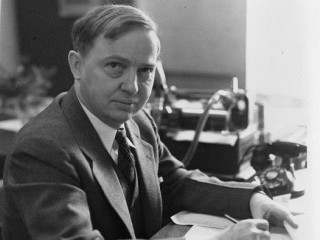
Harlow Shapley biography
Date of birth : 1885-11-02
Date of death : 1972-10-20
Birthplace : Nashville, Missouri
Nationality : American
Category : Arhitecture and Engineering
Last modified : 2011-06-03
Credited as : Astronomer, solar system, Milky Way, Harvard Observatory
The American astronomer Harlow Shapley proved that our solar system is only a peripheral member of our galaxy. He is credited with bringing Harvard Observatory into a position of preeminence in the world of astronomy.
Harlow Shapley was born on Nov. 2, 1885, in Nashville, Missouri, where his father was a successful hay producer and dealer. Harlow received his early education in a one-room country schoolhouse. About age 15, he went to a kind of business school in Pittsburg, Kansas, and within a year, became a newspaper reporter. He saved his money and resolved to get educated." He was accepted by the Carthage Collegiate Institute, from which he graduated in 1907 as valedictorian of his class.
Shapley then entered the University of Missouri, intending to study journalism, but, finding no degree program available, took up astronomy—and never put it down. In 1910 he received his bachelor's degree; the following year he completed his master's degree. He received the valuable Thaw fellowship of Princeton University and began studying under H. N. Russell. In 1913 Shapley received his doctoral degree.
Shapley's thesis, a lasting contribution to astronomy, dealt with methods for determining the physical properties—for example, the period of revolution, the orbital inclination, and the mean density—of eclipsing binary (double) stars from their light curves" (their intensity as a function of time). From the outset of his work, however, he had a pressing desire to determine the distances to these stars, and, after a trip of several months to Europe, Shapley went in 1914 to Mt. Wilson Observatory to study stellar distances. He made a giant step forward in his research program when, within a year, he realized that the variable Cepheid stars are not eclipsing binaries but single pulsating stars. Their distances, therefore, could be determined by measuring their apparent magnitudes, using Henrietta S. Leavitt's 1912 period-luminosity relationship to obtain their absolute magnitudes, and employing the inverse-square law. Furthermore, since pulsating Cepheid stars frequently occur in the so-called globular clusters, Shapley could employ the former to determine distances to the latter.
Using Mt. Wilson's 60-inch reflecting telescope, Shapley took numerous photographs from 1916 to 1917. Analyzing them, he discovered that although the globular clusters are symmetrically distributed about the plane of the Milky Way, most appear to be concentrated in the direction of the constellation Sagittarius. From these observations, Shapley drew the revolutionary conclusion that our solar system is not at the center of our galaxy but is actually far (roughly 50,000 light-years) off-center. Thus Shapley in 1917 displaced the sun from the center of our galaxy. Moreover, Shapley concluded that our galaxy, lens-shaped, is of immense dimensions: 300,000 light-years in diameter and 30,000 light-years thick. (These estimates had to be revised later to take account both of interstellar absorption and W. Baade's work.)
This revolutionary discovery stimulated protracted debate and was undoubtedly Shapley's greatest single achievement. But his contributions to astronomy by no means stopped in 1917. Four years later he became director of Harvard Observatory and for more than three decades thereafter, simultaneously carried out creative research and fulfilled his administrative duties. He became known as Mr. Magellanic Clouds" for his many studies on this pair of relatively close-by, irregularly shaped galaxies; he discovered in 1938 the first of the dwarf sculptor-type galaxies; he directed immense surveys of stellar spectra and galactic populations—all this, and much more, while bringing the overall research and instructional programs of Harvard Observatory to a position of preeminence in the world.
In addition to being elected to the National Academy of Sciences in 1924, Shapley received numerous honorary degrees, medals, and other high honors. In 1952 he became director emeritus and Paine Professor of Astronomy at Harvard, and in 1956 professor emeritus. He died in 1972.
















